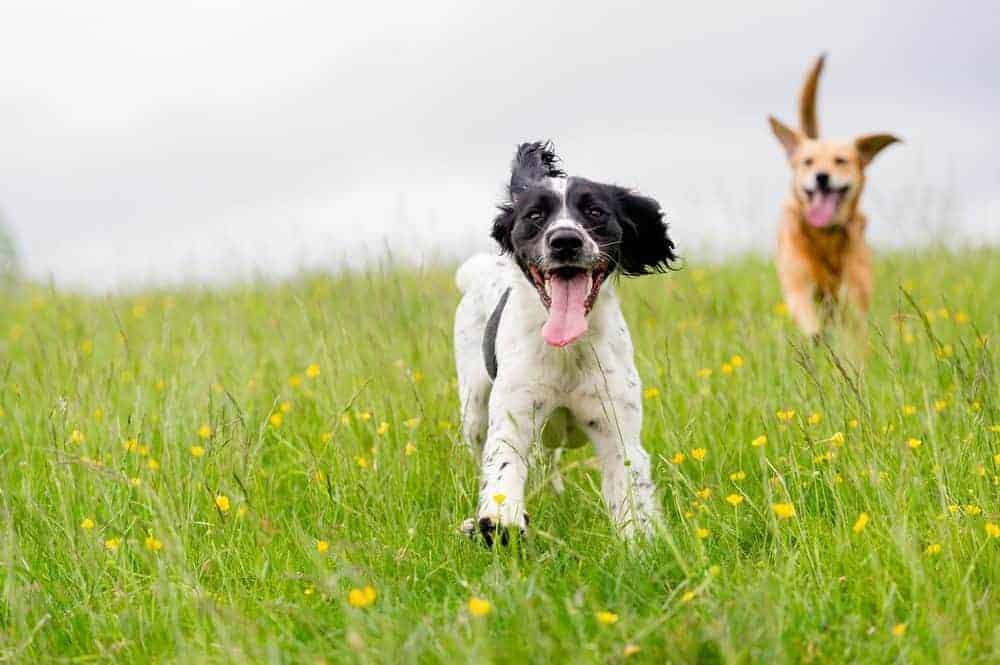
May means spring is in full bloom, with blossoms and bluebells beckoning both two and four-legged nature lovers to get outside and enjoy some long country walks. It’s also national Walk in the Woods month, which is another great reason to explore the best that the season has to offer. However, being out and about in the countryside makes having a good recall even more important. Here’s what (and what not) to do...
DO start by teaching the basics of recall in your back garden where there are few distractions. Most dogs pick it up quite quickly when there are some tasty treats involved as a reward. Try throwing a treat a distance away, then, once your dog has eaten it, call them back to you, giving them lots of praise and a treat when they run back to you.
DO practice regularly. This is absolutely essential to getting a reliable recall. Once your dog has nailed the basics, pick safe situations where there are low key distractions and gradually build up the distance that you’re able to call your dog and they respond.
DON’T use the word ‘come’. For most dogs, this word has developed a negative connotation – essentially ‘stop your fun now!’ Start with a new, intriguing recall cue – it could be ‘sausages’ or ‘this way’. Alternatively, try introducing a high-pitched dog whistle that your four-legged friend can learn to associate with something really good to eat or play with.
DO give your pet lots and lots of praise when they come trotting back to you. And, if they’re doing something fun – such as pursuing a scent trail in the bushes or playing with a doggy friend – let them go back to it. This proactive, rather than reactive, approach means you’re not punishing them by taking them away from the good stuff, which, understandably, will make them reluctant to return. Instead, it’s teaching them that coming back to you is a rewarding detour rather than an end to the fun.
DO use high value treats. For most dogs, food is a great reward and the tastier and smellier the better. Use slivers of cooked chicken or a chopped-up sausage just for walks where there are likely to be some serious distractions. For those dogs who aren’t so food oriented, a favourite ball or tuggy toy can lure them back successfully. The aim is for your dog to learn that the benefits of coming back to you outweighs the cost of whatever else is on offer.
DO think carefully about when to let your dog off-lead when you’re out in the countryside. If you can’t see all the boundaries of the field you’re in, or far along the woodland path, what could appear over the horizon?
DO plan your route. Think about how reliable your dog’s recall is as well as what his or her reaction will be to things they may encounter –whether that’s cows, sheep, horses, other dogs, walkers, joggers, cyclists or tractors. Plan to avoid potential trouble spots – such as fields with livestock, cycle paths, bridleways, or woods with deer and rabbits – whatever you think your dog may struggle with.
DON’T lose your cool. A dog that ignores you can be one of the most frustrating experiences ever – but showing how irritated you are will only serve to keep them away. It’s absolutely essential that recall is always a positive experience.
DON’T tell your tardy dog off when they eventually do come back as this simply teaches them that they were right all along and returning was a bad idea.
DO try to see things from your dog’s perspective. Usually, the interesting stuff your dog is investigating outweighs their motivation to return to you. It’s down to you to persuade them that you (with your pockets full of treats and toys along with plenty of praise to give) really are worth coming back for.
For more advice, the charity Dogs Trust has a great factsheet on training recall >>
Find a forest near you to explore at Forestry England >>
Remember to always follow the Forestry Commission’s four-point Forest Dog Code:
1. Take the lead
Forests are great spaces for your dog to enjoy, just make sure you know when to use the lead.
2. Keep your eyes peeled
Please respect other visitors and wildlife, keep your eyes open and your dog within sight.
3. Have good control
Does your dog come when called? Make sure your dog understands your commands to keep you both safe.
4. Keep our forests clean
Bag and bin your dog’s waste where you can, or ‘stick and flick’ it when you are deeper into the woods.
If you found this interesting, you may also like:
Are you going down to the woods today?
Here’s what you need to know to stay safe if you and your dog are going wild in the country...
The value of reward-based training with your dog
Focusing on and rewarding what your dog can do, rather than what they can’t, makes training a much more positive experience for canines and humans alike
Tailor your training to your dog’s personality
When it comes to teaching your dog new stuff, it's never a case of one size fits all. Canine behaviour experts agree that tailoring your approach by understanding the way your dog learns is key to success
Is taking your dog for a walk a tug of war?
Pulling on the lead is a behaviour that many dog owners grapple with on a daily basis. But with training, patience and plenty of encouragement, every dog can learn to walk nicely on the lead.
Sources: forestry.gov.uk, woodlandtrust.org.uk, bluecross.org.uk, dogstrustschool.org.uk














